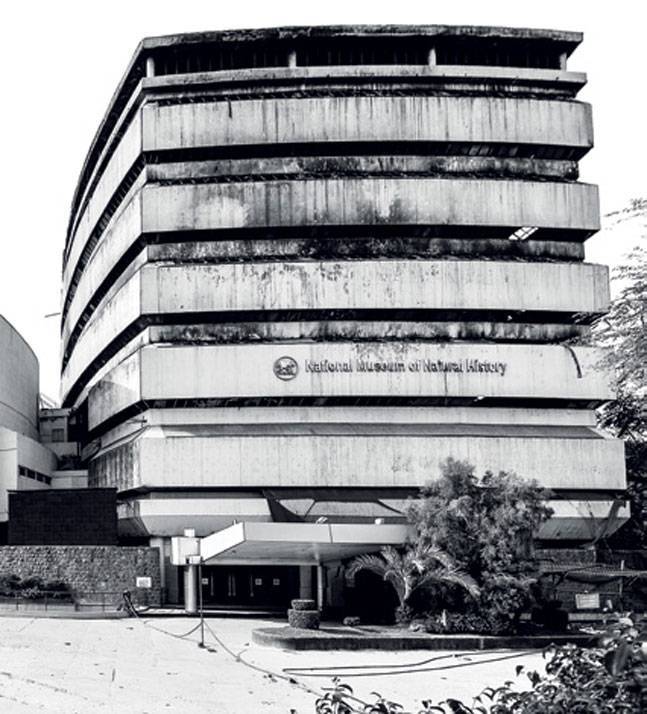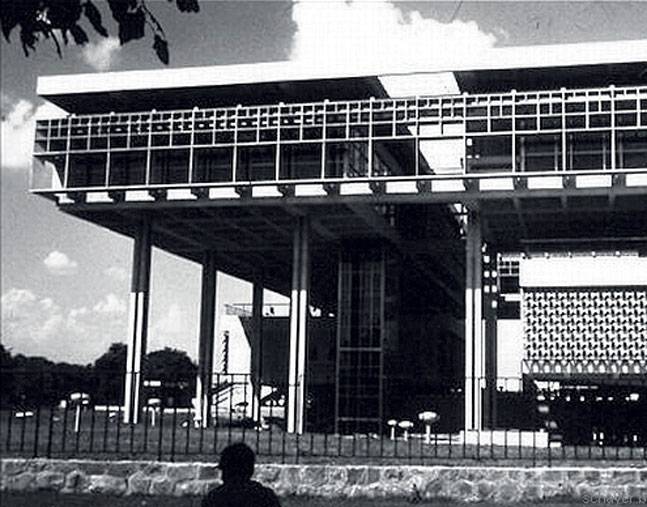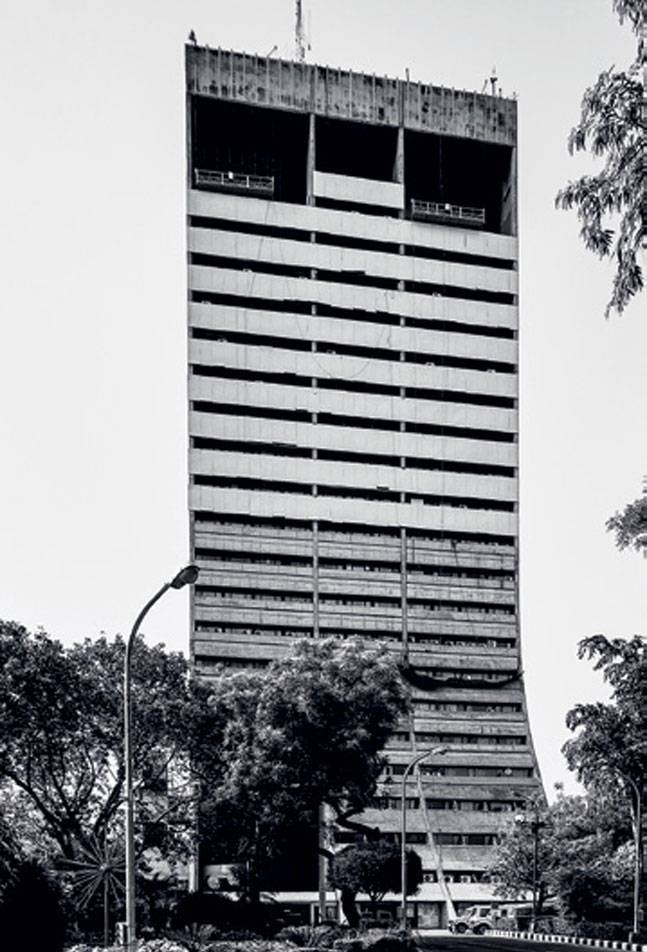Delhi: Monuments (general issues)

For individual monuments please click Places at the bottom of this page and look up under the concerned letter e.g. 'Delhi: J' Or enter the name of the monument in the Search box.
Contents |
After 1947
Varun Shiv Kapur , Brutalist Delhi “India Today” May 12, 2017
AKBAR HOTEL
Architect: Shiv Nath Prasad
Year: 1969
Akbar Hotel in Chanakyapuri is an archetypal brutalist building. Its bold form, heavy massing and straight lines project the no-nonsense attitude of the movement.
IIT DELHI
Architect: JK Chowdhury
Year: 1968
The main academic block of IIT Delhi is one of the city's earliest brutalist structures. This imposing building exudes the requisite seriousness and heft to house one of India's premier academic institutions.
SRIRAM CENTER
Architect: Shiv Nath Prasad
Year: 1969
Shiv Nath Prasad worked on both the Akbar Hotel and the Sriram Center for Performing Arts at Mandi House at the same time. The Sriram Center is the smaller of the two, and plays with its bold massing while still indicating externally the functions of its different interior spaces.
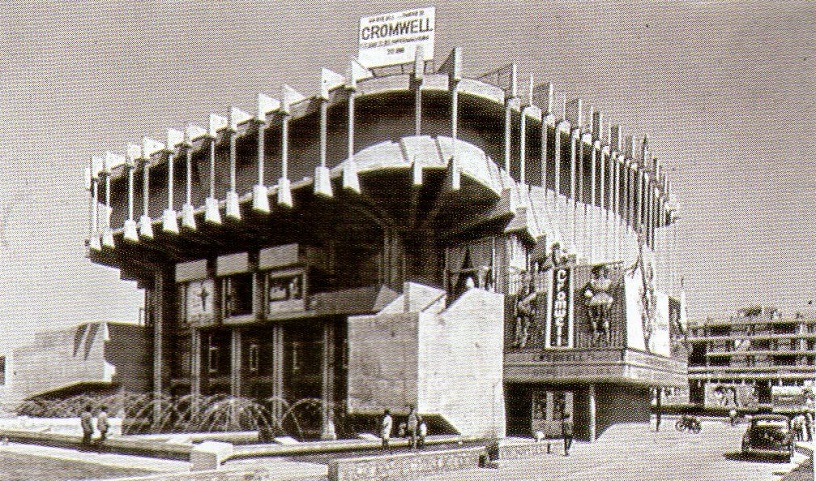
CHANAKYA CINEMA HALL
Architect: PN Mathur
Year: 1970
The side facade of the once iconic and now demolished Chanakya cinema at Chanakyapuri resembled a whale held aloft on columns. This is because its exterior followed the shape of the auditorium inside, and it proudly displayed its structural components on its skin, creating an evocatively shaped building.
HALL OF NATIONS AT PRAGATI MAIDAN
Architect: Raj Rewal
Year: 1972
The recently demolished Hall of Nations was a unique structure. It wore its three-dimensional lattice structural framework unabashedly as its skin, unhidden behind any form of covering. It was essentially a huge shed or hangar, but the aesthetics of its design and engineering elevated it to a thing of raw beauty, and at the time a symbol of India's progressive desires.
FICCI BUILDING (NATIONAL MUSEUM OF NATURAL HISTORY)
Year: 1972
Not many people would call the National Museum of Natural History a thing of beauty. As an unapologetic exposed-concrete building with a severe industrial aesthetic, it fit right in with the other brutalist structures coming up in the 70s. The museum was unfortunately gutted by a fire in 2016.
POLISH EMBASSY
Architect: Witold Ceckiewicz
Year: 1973
While driving down Shanti Path in Chanakyapuri towards Moti Bagh, you might have glimpsed a modernist building whizz past you on the left, just before the last roundabout before the Moti Bagh flyover. This gem is the Polish Embassy, easily one of the most interesting modernist structures in the city.
TIBET HOUSE
Architect: Shiv Nath Prasad
Year: 1974
Like many of the buildings on this list, the Tibet House on Lodhi Road is like a breath of unabashed modernist fresh air in the sea of ho-hum structures. It is an almost square box raised on a smaller base, and one of the more compact examples of exposed concrete, egg-crate facade structures from the 1970s.
NCDC BUILDING AND NDMC PALIKA KENDRA
Architect: Both Kuldip Singh
Year: 1980 and 1983 respectively
These are two later examples of exposed concrete structures in the city, and among the better maintained. Palika Kendra on Parliament Street is a soaring, expressive concrete structure with a curved base, and the NCDC building on Khel Gaon Marg is a quirky stepped-pyramid building. A unifying thread connecting these two buildings, as well as Akbar Hotel, Sriram Center and the Hall of Nations, is the structural engineer associated with all of them: Mahendra Raj, who deserves much credit for the design of these structures.
Changes in 2018

From: Paras Singh & Mayank Manohar, Illegal shops regularised: Relief for traders, grief for residents, June 23, 2018: The Times of India
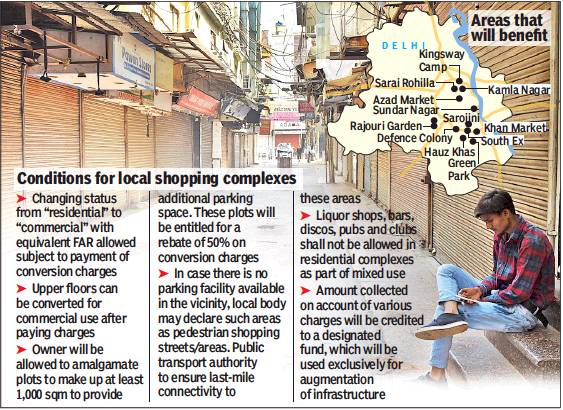
Areas that will benefit;
Conditions for local shopping complexes
From: Paras Singh & Mayank Manohar, Illegal shops regularised: Relief for traders, grief for residents, June 23, 2018: The Times of India
Centre Clears Changes In Master Plan
The ministry of housing and urban affairs has approved changes in the master plan 2021 for local shopping complexes (LSCs) to pave the way for legalising unauthorised commercial establishments across the capital and provide relief from sealings to traders.
While traders’ associations welcomed the step, RWAs complained about “rampant commercialisation and traffic chaos” the notification will create in the city.
The amendments will halt sealings at local shopping complexes, but drives will continue in other areas, the Supreme Court-appointed monitoring committee said. As per the changes, LSCs will get a uniform floor area ratio (FAR) of 350, at par with residential plots, as well as the use of basements for commercial activities on payment of conversion and parking charges. An FAR of 350 means commercial establishments from ground up to the third floor and half of the fourth floor can be legalised.
Local bodies have been directed to provide parking space in these markets.
Local shops up to 3rd floor are now legal
Owners Can Merge Plots To Have Common Parking Area
There are 106 local shopping complexes across the capital and most face acute parking problems.
Allowing an FAR of 350 means commercial establishments from ground up to half of fourth floor can be legalised.
LSCs already under commercial use zone are not liable to pay any conversion charges and the upper floors can be converted to commercial use after paying other applicable charges. Penalty charges have been brought down to 1.5 times the applicable charges, as compared to 10 times earlier.
In order to promote parking, owners will be allowed to merge plots — provided the amalgamated plot size is at least 1,000 sq metres — and have a common parking area. Such plots shall be entitled to a rebate of 50% in conversion charges. Rebate on levy of conversion charges and amalgamation of plots have been introduced to incentivise the creation of parking space.
Local bodies will have to provide parking space for every local shopping complex. In case no plot is available, either a common parking would be developed in the vicinity or the market would be declared a pedestrian street. As per the proposed changes, the local bodies should develop parking facilities and other basic amenities from the fund collected through conversion and parking charges.
“The major challenge for civic bodies is to earmark parking space because of acute shortage of land. However, now when the notification is done, we will have to implement the changes. We will devise a plan for development of parking facilities wherever possible. In case parking facility cannot be developed, the market will be declared a pedestrian street,” said a senior official from the north corporation.
On mandate from the SC, the monitoring committee had in December last year directed civic bodies to start sealing establishments running in violation of the master plan at LSCs. Shops across the city, including including markets such as Defence Colony, Greater Kailash I N block market, Hauz Khas, Green Park and Sundar Nagar, were sealed. As traders protested, the drive became a hot issue with all political parties coming out in their support.
Civic officials pointed out that owners whose shops were sealed will have to apply for de-sealing and produce the required documents.
In February, DDA had issued a public notice inviting suggestions and objections from people to amend the master plan 2021. After DDA had made changes in the master plan and sent it for further notification, the apex court stayed the amendments. The court, however, allowed DDA in May to invite suggestions and objections from citizens and hold public hearings before making changes in the master plan.
Praveen Khandelwal, general secretary of the Confederation of All India Traders (CAIT), welcomed the notification, saying that the move will provide relief to over 5 lakh people. “These are timely and needed amendments. But several other issues also need to be tackled by the urban development ministry, such as the confusion over the status of special areas like Chandni Chowk and L&DO markets,” he said.
“Also, the matter of non-notified roads as well as the need to start a fresh survey for notification of more roads under mixed-land use and commercial category needs to be taken up. CAIT will soon meet Union housing and urban affairs minister Hardeep Puri to resolve these issues,” Khandelwal said.
CAIT has also demanded that the civic bodies should on their own start de-sealing shops that have got relief. In a circular issued by DDA a few days back, the agency had reaffirmed that it will not allow pubs and other liquor-serving establishments in mixeduse residential colonies. It was a move aimed at appeasing residents miffed over legalisation of unauthorised shops. A DDA official said these as well as other rules on allowing air conditioning vents were part of existing provisions which the agency has reaffirmed through this regulatory framework.
Category-wise/ types of monuments
Eight types of monuments in Delhi: NMA
FOR FRAMING BYLAWS
The Times of India New Delhi: TIMES NEWS NETWORK Jul 30 2014
Over four years after the new and amended ASI Act was enforced, the process of framing heritage bylaws for Delhi’s protected monuments is taking longer than ever. Only bylaws for Sher Shah Gate and Khair-ul Manzil have been notified, with the process for final notification of Begumpuri Masjid’s bylaws still an ongoing one. Under pressure to speed up the process, National Monuments Authority is looking at eight categories of monuments to identify characteristics of each for framing of common bylaws.
A draft outlining the categories has been prepared to which NMA has invited objections and suggestions from the public. ASI is also being consulted for views. On the list, though, there are only 160 protected monuments existing in Delhi, with the remaining 14 either missing or denotified.
“The draft has been prepared in accordance with regulations of ASI Act. It will eventually be sent to the culture ministry for final phase notification,“ said a top NMA official. The categories are also expected to help in urban development projects in which clearances will be required for monument-controlled areas. The categorization was mostly done internally within NMA, though comments and suggestions were invited from experts from various fields like architecture, conservation, urban planning, etc. Once the categories are notified by the Centre, monuments under various categories will get the official tag. “It will also help in the protection of monuments and increasing tourist foot fall. Monuments that face threats of ur banization and encroachment have been listed separately so that a closer tab can be kept on them,“ said an official.
While Delhi has three world heritage sites--Qutub Minar, Humayun's Tomb and Red Fort, ' ' first category of protected monuments and archaeological sites inscribed S on Unesco's world heritage list also includes monuments like Arab ki Sarai, t Nila Gumbad, Hindu Iron Pillar and Tomb of Afsar-wala which fall in the vi i cinity of these sites.
Category II has ten monuments including Delhi Gate, Ajmeri Gate, Mutiny Telegraph Memorial, and Tomb of Razia Begum which are on a tentative Unesco heritage list.
The third category has ten buildings located in New Delhi area while the fourth category consists of ticketed monuments. Category V only mentions Najaf Khan Tomb as a monument with an adequate flow of visitors identified for charging fee. The sixth category consists of living monuments which receive a large number of visitors and pilgrims and buildings where worship and rituals are conducted.
The seventh category has monuments located in urban/semi-urban limits and remote villages. Sources said this category is critical. It’s further classified in three sub-categories on basis of intensity of urban pressure. While subcategory A has 18 monuments facing severe urban pressure with heavy construction activity in close vicinity, subcategory B has some monuments facing urban pressure but possessing significant greenery.
The final (eighth) category includes archaeological parks
Laws, rules
2018: Humayun’s Tomb bylaws to serve as model
Richi Verma, October 24, 2018: The Times of India

From: Richi Verma, October 24, 2018: The Times of India
Delhi’s Humayun’s Tomb group of monuments and Lucknow’s Amjad Ali Shah’s mausoleum will be the beneficiaries of model heritage bylaws, to be followed by all centrally protected monuments nationwide.
The National Monuments Authority recently decided that the bylaws of these two sites would be finalised on priority and forwarded to the ministry of culture for submission in both Houses of Parliament during the winter session. According to NMA, all heritage bylaws for centrally protected monuments will be prepared in accordance with these model heritage bylaws.
The Humayun’s Tomb group of monuments comprises 28 protected monuments, including the world heritage site itself, monuments in Sunder Nursery and Nizamuddin Basti, tombs of Battashewala Complex, Neela Gumbad, Sabz Burj and Rahim Khan’s tomb. The bylaws have been prepared by the Aga Khan Trust for Culture (AKTC), which is working on the conservation of many of these sites, in partnership with ASI.
Heritage conservation aside, AKTC has also been working in partnership with ASI, CPWD and south corporation on the Nizamuddin urban renewal initiative. Through the years, AKTC has developed a significant understanding of the Humayun's Tomb sub-circle, which is also a DDA master plan designated conservation area. “The 28 monuments fall in three categories: Humayun’s Tomb complex, heritage zone and living monuments in Sunder Nursery and Nizamuddin Basti. The first is the most important,” an official said.
Planning by AKTC started several months ago. The first step comprises detailed archival research required to precisely define the limits of protected area of each monument not mapped by ASI. Senior officials said the aim was to not only work within the framework of the Act — that prohibited construction within a 100m radius of the monument — but also to emphasise on parameters, such as visual linkages, physical access and preparing urban design guidelines, that would allow residents to benefit from living within a heritage zone rather than be penalised for it.
The biggest hurdle lies in illegal constructions rampantly coming up within the 100m prohibited zone in all monuments, not only destroying the heritage character and aesthetic appeal of the site, but also posing a threat to human safety. Put together in haste, these ramshackle structures are highly unsafe, although some in Nizamuddin go up to seven storeys.
“AKTC is discussing limiting the area of prohibited zones wherever this does not impact the monument and extending these towards the east of Humayun’s Tomb where historic visual linkages with the river were a significant reason for locating these Mughal-era monuments here,” an NMA official said. NMA has requested AKTC to prepare 3D models to study the impact of potential permissible construction in the heritage zone. Permissions are already being sought by AKTC to carry out muchneeded housing improvements in the densely built-up Hazrat Nizamuddin Basti. AKTC is also outlining potential incentives for residents.
The 28 monuments fall in three categories: Humayun’s Tomb complex, heritage zone and living monuments in Sunder Nursery and Nizamuddin Basti.
Missing monuments
1960s-2015: how some monuments subsumed in urban villages
The Times of India, Aug 21 2015

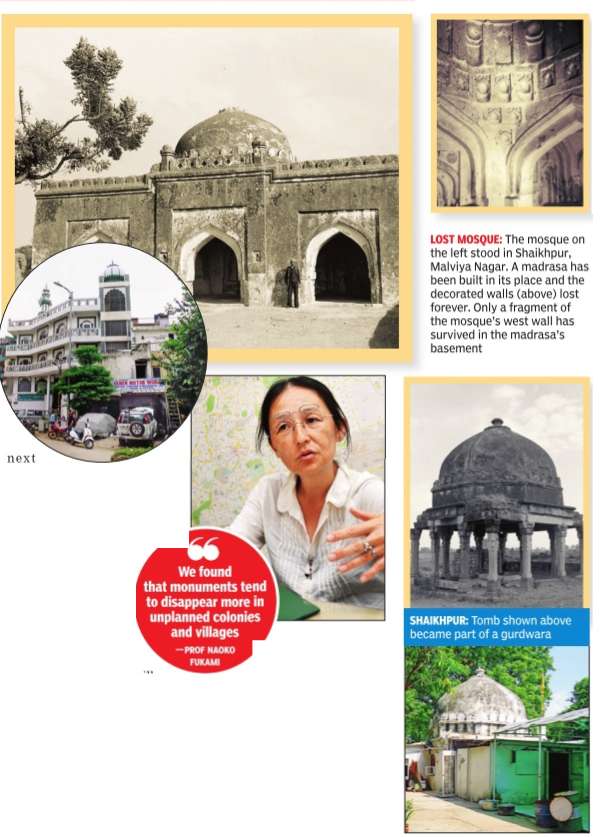

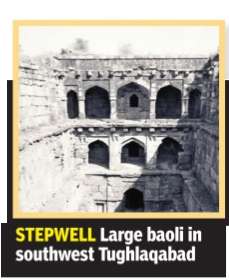



Richi Verma
City's monumental loss
Japanese team retraces steps of archaeological experts who visited Delhi in 1960 and finds many of the monuments they saw missing
Until the 1960s, there was a large baoli with four lev els in southwest Tugh laqabad that--although not lined with as many arches as Agrasen ki Baoli near Connaught Place--would have counted among the city's finer mediaeval stepwells.An expanding village swallowed it whole at some point in time.
The baoli would have been completely forgotten but for the documents and plate camera images left behind by a Japanese team that surveyed more than 400 monuments over six months during 1959-60. Fifty five years later, another Japanese team is revisiting those monuments to document the changes they have undergone. So far, their findings have been disappointing. In less than 10 days, the five experts have traced about 80 of the loca tions but found that many of the striking mosques and tombs that stood there have disappeared, while many others are barely recognizable today .
“Our aim is to com pare how the monuments and the urban setting around them have changed,“ said Prof Naoko Fukami, director of the Japan Society for Promotion of Science research station in Cairo, who is leading the team as part of a research project.
The 1960 survey team had selected 400 monuments from a list compiled by Maulvi Zafar Hasan in the early-1900s. “Now we want to see how these 400 monuments have evolved since then, she said.
The Japanese team is working with the Delhi chapter of heritage conservation body Intach, which is helping them get permissions from ASI, the state archaeology department and other agencies for visits. It has covered Chirag Dilli, Tughlaqabad, Siri Fort, Hauz Khas and Malviya Nagar and will survey Mehrauli, Nizamuddin, central Delhi and Old Delhi before the project concludes next y e a r.The 1960 team included three historians and a senior professor.
“We found that monuments tend to disappear more in unplanned colonies and villages,“ said Fukami. villages,“ said Fukami.“In Chirag Dilli, a new mosque has come up in place of a Lodhi-era mosque. Only portions of the old wall are visible. Many other monuments have been altered and defaced. The team's research will be compiled in three volumes and serve as reference material for future projects.
Intach officials said the project shows how Delhi's heritage is disap pearing rapidly . “So far we've had the Zafar Hasan list of 1912 which is not very well detailed, and then we came out with the Intach Built Heritage listing in 2000. This survey from 1960 shows how the monu ments have evolved through the decades and is a new reference point for us, said Intach convener Prof AGK Menon.
Intach's director (project) Ajay Kumar said, “Currently, we are working on unprotected monuments and the survey provides new resource material for us. The findings are a matter of concern and need to be addressed.
2019: 13 of 174 ASI monuments no longer exist
Richi Verma, January 20, 2019: The Times of India
There are 174 centrally protected monuments in Delhi, of which at least 13 are missing or untraceable. While the Archaeological Survey of India has failed to update its official “missing” list, sources in the agency revealed that many of the sites had either been traced or their names were entered incorrectly in the first place due to dual notification.
According to sources, a report prepared in 2014 by ASI’s Delhi circle claimed to have found at least four monuments
on the missing list. Yet, till date, the official list has failed to reflect this. The exercise to trace the missing monuments was undertaken after the Comptroller and Auditor General rapped ASI for poor maintenance of national heritage.
The missing monuments are divided between the Delhi circle and the mini-circle. There are four listed missing monuments in the Delhi circle — a tomb with three domes in Nizamuddin, a mosque known as Shamsi Talab in Mehrauli and two unnamed mosques in Munirka. In the mini-circle, there are nine missing ASI monuments. These include Moti Gate of Sher Shah’s Delhi, Phool Chadar near Najafgarh, Alipur cemetery, Barakhamba cemetery and Nicholson’s statue, among others.
Over time, some of the sites have been removed from the missing list. “The Joga Bai mound was listed as missing, but ASI traced it to deep inside Shaheen Bagh, a heavily encroached-upon site. It was demarcated and struck off the list. Neeli Chhatri in Nizamuddin was similarly removed from the list and denotified,” an official said.
However, sources said there were still several monuments that had been identified and needed to be removed from the list. “The tomb with three domes has been located inside Golf Course. Moti and Sher Shah’s Gate are the same monument with dual notification. Similarly, the listing under the mosque known as Shamsi Talab has a dual notification under Hauz-e-Shamsi. The statue of Nicholson has been traced to Ireland where it was gifted by the Centre in the 1960s. It stands today in the school where Nicholson had his primary education,’’ an ASI official said.
Some sites that are actually missing are Phool Chadar, the three sites of Siege Battery and Incha Wali Gumti.
Monuments of national importance
Shahjahanabad/Old Delhi/ Walled city: Mughal, British monuments
The Times of India, Dec 13 2015











Old Delhi now richer by 300 heritage buildings
RichiVerma
10 UNSUNG GEMS OF WALLED CITY
Every nook and corner of the Walled City has a story to tell--from the sprawling havelis that have witnessed the glory of Mughal and British empires, to the many galis, chowks and bazaars that have evolved over generations. After years of researching and surveying, Indian National Trust for Art and Cultural Heritage (INTACH) has finally completed the challenging task of documenting heritage buildings in the area. There are 1,064 such buildings now-an increase of 300 over the previous list. The new survey lists 303 havelis (mostly owned privately) and other buildings that were overlooked earlier. The municipal corporation had notified 187 Old Delhi properties as protected several years ago. When heritage experts insisted on protection for many more buildings, INTACH published a list of nearly 550 buildings, mostly privatelyownedhavelis, that had unique architectural features. This list is still pending notification with the urban development department. Said an INTACH official. “We started surveying the streets and identifying properties that had historical elements in them-anything from old railings to arches--and listed them for protection. In the final survey we found 303 buildings and havelis. All the properties have been graded in terms of architectural and heritage value. The list includes notable havelis like Namak Haram ki Haveli in Chandni Chowk as well as gateways in Old Delhi's mohallas that had not been included earlier. Most of the properties are from the Colonial period, but some date back to the Sultanate and Mughal eras. Most of the havelis are located in the congested lanes of Sitaram Bazaar, Khari Baoli, Kucha Pati Ram, HauzQazi and the Jama Masjid area.While some are in relatively good condition, many are falling to pieces as their owners have not maintained them. “The objective of the survey was also to identify these heritage havelis and give their owners incentives and support to preserve them. The final list has been sent to Shahjahanabad Redevelopment Corporation, which is framing policies to give incentives to haveli owners for maintaining the buildings as well as financial assistance, said an official.The scheme is open to notified heritage buildings. Only a fourth of the 1,064 listed heritage properties in the Walled City have any kind of protection. In recent times, a number of old havelis have collapsed due to neglect or the impact of unauthorised construction in their vicinity.
Heritage buildings in Delhi: 2nd list
Richi Verma, Heritage gets second wind in Walled City, Jan 14, 2017: The Times of India





As extraordinary as it may sound, given its historic significance, the 17th century Jama Masjid in Old Delhi never enjoyed official protection. That will change now with the country's largest mosque becoming a protected structure, along with 550 other heritage buildings in the Walled City . Delhi government has notified them under Section 7.26 of Delhi Building Byelaws for Conservation and Protection.
Of the heritage buildings notified in the second list, the first list having come out in 2010, 526 fall under the jurisdiction of the North Delhi Municipal Corporation and 25 under the South Delhi Municipal Corporation. Apart from Jama Masjid, some others slated for protection and conservation are Nigam Bodh Ghat, Anglo-Sanskrit School, Gadodia Market, Ambedkar University offices, CPI(M) office building, the Taj Mahal Hotel on Church Mission Road and the Canara Bank building in Daryaganj.
“Of the 551 buildings, at least 475 buildings are havelis,“ said an official.“Protecting the Walled City's havelis has been a priority for many years. Now, any construction work related to a protected haveli will require the permissions of the municipal corporation and the heritage conservation committee. Left out of the first list, conservationists later felt that the sprawling havelis, most of which had historical elements associated with them, needed protection to prevent any alteration to their original character.
While alteration might no longer be easy , owners of protected havelis would, however, now be eligible to receive government funding for the maintenance of their buildings. Prohibitive maintenance and repair-related costs had led to a large number of Old Delhi's havelis facing decay .
Dec 2017/ Begumpur Masjid, Sarai Shahji Mahal enter list
Aurangzeb may be anathema to the ruling establishment but Tughlaq, it seems, will pass muster. Culture minister Mahesh Sharma told Rajya Sabha that his ministry had declared Begumpur Masjid and Sarai Shahji Mahal, both in Delhi, as monuments of national importance. The move is also expected to tackle complaints received from ASI field offices about unauthorised construction.
Begumpur Masjid is one of the seven mosques said to have been built by Khan-i-Jahan Junan Shah, the prime minister of Firoz Shah Tughlaq who ruled India in the 14th century. Although it resembles the Khirki and Kalan masjids, the single-storey mosque stands on a raised plinth and its large courtyard is enclosed by arched cloisters on all sides and houses a three-aisle deep prayer hall.
The Sarai Shahji Mahal, on the other hand, is a group of monuments which contain a mosque comprising compartments topped by a curved Bengali roof, and a mahal having a courtyard with a few graves surrounded by an arcade and an enclosure containing graves dating back to the late Mughal period.
Octagonal tombs
Varun Shiv Kapoor , Rebirth of a tomb “India Today” 12/2/2018

See pic
Hundreds of historic tombs dot the urban landscape of Delhi. Among these are five octagonal tombs that occupy a special place architecturally, for the unusualness of their design, their graceful form and the stylistic cohesiveness between them.
Each of these tombs consists of a large octagonal central chamber with an arcaded walkway wrapped around it. The eight external corners of the walkway have a characteristic buttress, and between each thick corner spring three tall arches. Above the arches runs a continuous bracketed stone chhajja. The tomb's large central dome is encircled by smaller domes or chhattris.
Three of these tombs were built during the Sayyid and Lodi period, and are located in Kotla Mubarakpur (Mubarak Shah, mid-15th century) and Lodi Gardens (Muhammad Shah, mid-15th century, and Sikandar Lodi, early-16th century). Another is from the Suri interregnum, located near Humayun's Tomb (Isa Khan, mid-16th century). However, the first of the series (and the first octagonal tomb built in India) is that of Khan-i-Jahan Tilangani (mid-14th century), prime minister to Firoz Shah Tughlaq. This tomb is located in the winding lanes of Nizamuddin basti, south of Nizamuddin Auliya's dargah.
Till recently, Tilangani's tomb was almost completely enclosed by present-day construction, built by multiple families living in different parts of the structure. A few months ago, the Aga Khan Trust for Culture started the process of relocating the families and clearing a portion of the area around the tomb. The central chamber was made accessible and many feet of accumulated earth and debris were removed to reveal multiple graves. The structure is being strengthened to prevent collapse. As more of the edifice is painstakingly uncovered, the detailing and elegance of its architecture are slowly being exposed.
As the earliest octagonal tomb in India, and the first of the Delhi Five, Tilangani's tomb is an important part of both Delhi and India's architectural heritage. The fact that it is being day-lighted will hearten historians and heritage enthusiasts alike.
Threats to monuments
Infrastructure projects within 100 metres

From: Richi Verma, Stuck for yrs, infra projects set to clear 100m hurdle..., January 4, 2018: The Times of India
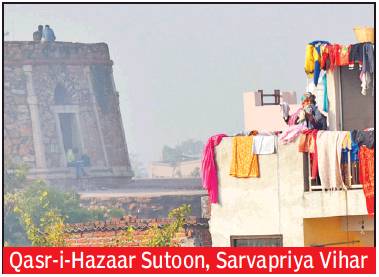
From: Richi Verma, Stuck for yrs, infra projects set to clear 100m hurdle..., January 4, 2018: The Times of India
Activists Fear Structural Damage To Protected Monuments
A parking lot on Kasturba Gandhi Marg, underground parking at Shahid Bhagat Singh Park, bridge near Salimgarh Fort, tunnel through Sunder Nursery — these infrastructure projects in Delhi have either been scrapped or stalled indefinitely because they fall within 100 metres of protected national monuments. But things are about to change with the Ancient Monuments and Archaeological Sites and Remains Act being amended to keep government and infrastructure projects out of such prohibition zones. Not surprisingly, heritage activists are up in arms, terming the change as sounding the “death knell for Indian heritage”.
The prohibited (100m) and regulated (101-300m) area restrictions were included in the Amasr Act of 1993 in order to safeguard protected monuments. There are 173 of them in the capital, and over 3,600 across the country. The Act was amended in 2010 to set up the National Monuments Authority as the agency to enforce the 100-m ban.
This provision has, however, encountered stiff resistance from sections of the public. Government agencies rue that in a city like Delhi, where heritage structures are common given the city’s antiquity, a ban on constructions in their proximity is an impediment to development. Residents unfortunate enough to be living within these controlled zones grumble that they cannot even repair their houses without permission.
“The actual threat to monuments is not from a few residential houses, but from the huge infrastructure projects which can now be undertaken, thanks to this amendment,” said an alarmed heritage activist. “There will be no one to check the damages that ancient structures will suffer from such development projects. Government agencies anyway have never exhibited sensitivity about protecting heritage.”
Sources confided that the decision to amend the law stemmed from three stalled national projects: an elevated national highway near Akbar’s Tomb in Agra, railway line near Rani ki Vav in in Gujarat and the Kolkata Metro. Work at these sites is expected to proceed at full speed now. “Damage to monuments might not only be visual but also structural,” explained a conservation architect. “It’s a pity the Act has been amended.”
In Delhi, while the National Monuments Authority had cleared projects on a case to case basis, the lifting of the ban on construction could give rise to new projects or revive dormant ones. “The ramifications of the amendment are huge,” said Swapna Liddle, convenor, Intach Delhi Chapter. “Delhi Metro can construct a flyover in front of Qutub Minar and there can be no opposition.”
Liddle said the issue did not involve substantial stretches of land. All that was needed was just 100 metres or so of land around monuments to protect them from vibrations, structural damage and marred aesthetics.
The actual threat to monuments is not from residential houses, but from infrastructure projects which can be undertaken after the new amendment... There will be no one to check the damages that ancient structures will suffer from such development projects.
Activities requiring permission of the National Monuments Authority
Private construction
January 4, 2018: The Times of India
The Ancient Monuments and Archaeological Sites and Remains (Amendment) Bill was passed by the Lok Sabha, lifting the ban on government and infrastructure projects within a 100-metre buffer zone around protected monuments.
But this is unlikely to provide relief to residents who own properties within such controlled zones. This is because while the amendment now permits construction of public infrastructure in the hitherto prohibited radius, the culture ministry clarified that no private projects will be allowed.
A large of number of monuments is located in densely populated residential areas such as Green Park, Hauz Khas, South Extension, Nizamuddin, Greater Kailash and Saket. Since the lifting of the ban does not relate to private constructions, the problems confronting residents in repairing homes, building additional floors or carrying out alterations will persist. Such activities will continue to require the permission of the National Monuments Authority.
"I have been pursing this problem with the Archaeological Survey of India for two years now. My family is growing and we need to build a second floor, but ASI dismisses it as not permissible," complained Kanishk Gupta, who owns a house close to the Hauz Khas monuments.
Many residents argued that allowing big government development posed a bigger threat to monuments than private projects. Heritage experts agreed that private work should also have been allowed if the prohibition was being lifted for official projects. "If you allow government work, why not allow a few citizens to carry out a few constructions?" mused an expert.
"South Extension was established in 1959, way before anyone could have foreseen prohibitory rules about heritage," reasoned Manjit Singh Chugh, executive member, South Extension Residents' Welfare Association. "Today, over 60% of our colony falls under the controlled zone since there are protected monuments here. Many houses are in poor shape and have even been declared dangerous, but the owners cannot repair them." Claiming these rules are a harassment for such residents, Chugh said the RWA would go to court for a public interest litigation soon.
Other residents insisted the strict rules were unfair and the government itself did little to protect monuments. "I live near Neeli Masjid," said Major Rajnish Panwar (retd), a resident of Hauz Khas, "and have been watching it being encroached upon for years with no action from the authorities. The government is punishing law abiding citizens who are unfortunate to own properties in the vicinity of a centrally protected monument, but turns a blind eye to illegally occupation of the monuments. If you want to protect national heritage, at least do your duty properly."




